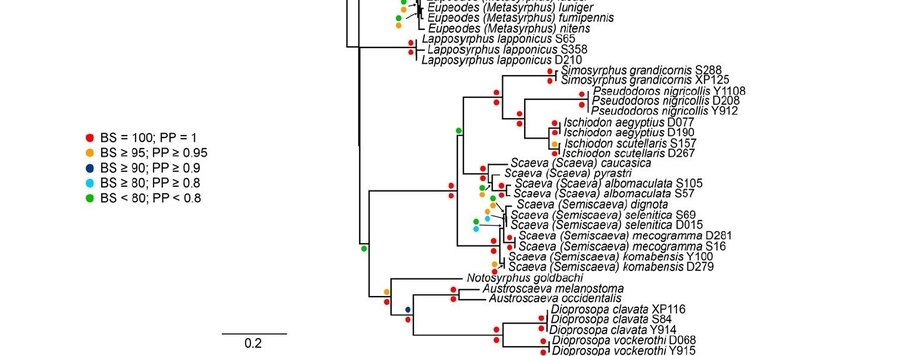
Molecular phylogenetics of Eupeodes-Scaeva
Phylogenetic relationships among the genera and subgenera of the Scaeva-Eupeodes clade (Diptera: Syrphidae: Syrphinae) were analyzed based on molecular characters. Sequence data from three gene regions were analyzed using maximum likelihood and Bayesian inference: the mitochondrial protein-coding gene cytochrome c oxidase subunit I (COI) and the nuclear 28S and 18S ribosomal RNA genes. The genus Paragus (single representative of the tribe Paragini) was resolved as sister group of the monophyletic Scaeva-Eupeodes lineage. Inside this clade, a Neotropical radiation of genera was well supported comprising Notosyrphus, Austroscaeva gen. nov., and Dioprosopa. For the first time, the placement of Doros, Pseudodoros, and Betasyrphus was inferred using molecular data. Our results resolved the genus Pseudodoros as sister group of Ischiodon, corroborating the generic rank of Ischiodon, Simosyrphus, Dioprosopa, and Pseudodoros. The current subgeneric division of Eupeodes with three subgenera is not supported by our data. Present results and the study of adult morphological characters prompted us to erect a new genus, Austroscaeva gen. nov., which includes four Neotropical species, that is, Austroscaeva melanostoma (Macquart, 1842) comb. nov., Austroscaeva occidentalis (Shannon, 1927) comb. nov., Austroscaeva patagoniensis (Kassebeer, 1999) comb. nov., and Austroscaeva penai (Marnef in Dusek & Laska, 1985) comb. nov. We described and characterized Austroscaeva gen. nov., and provided the description of the male of Scaeva patagoniensis (=Austroscaeva patagoniensis) and Scaeva penai (=Austroscaeva penai), as well as an illustrated identification key for the Austroscaeva species. Moreover, we explained and stated that the correct name for Syrphus lunatus Wiedemann, 1830 is Scaeva opimia (Walker, 1852).






